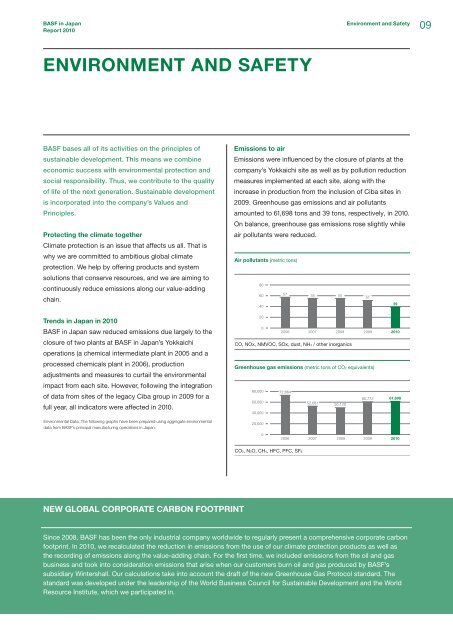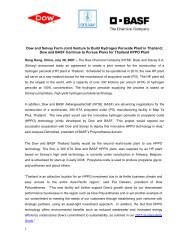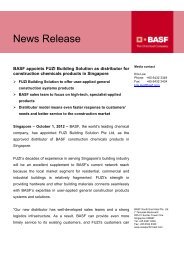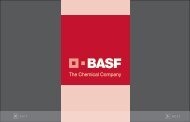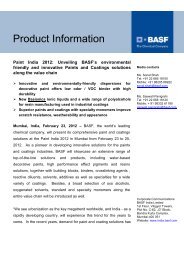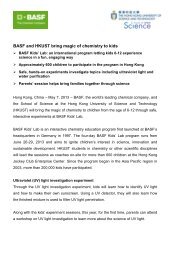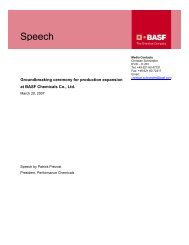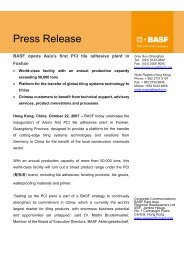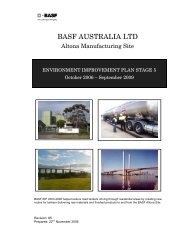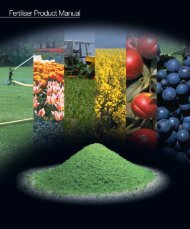BASF in Japan - BASF Asia Pacific
BASF in Japan - BASF Asia Pacific
BASF in Japan - BASF Asia Pacific
You also want an ePaper? Increase the reach of your titles
YUMPU automatically turns print PDFs into web optimized ePapers that Google loves.
<strong>BASF</strong> <strong>in</strong> <strong>Japan</strong><br />
Report 2010<br />
Environment and Safety<br />
09<br />
ENVIRONMENT AND SAFETY<br />
<strong>BASF</strong> bases all of its activities on the pr<strong>in</strong>ciples of<br />
susta<strong>in</strong>able development. This means we comb<strong>in</strong>e<br />
economic success with environmental protection and<br />
social responsibility. Thus, we contribute to the quality<br />
of life of the next generation. Susta<strong>in</strong>able development<br />
is <strong>in</strong>corporated <strong>in</strong>to the company’s Values and<br />
Pr<strong>in</strong>ciples.<br />
Protect<strong>in</strong>g the climate together<br />
Climate protection is an issue that affects us all. That is<br />
why we are committed to ambitious global climate<br />
protection. We help by offer<strong>in</strong>g products and system<br />
solutions that conserve resources, and we are aim<strong>in</strong>g to<br />
cont<strong>in</strong>uously reduce emissions along our value-add<strong>in</strong>g<br />
cha<strong>in</strong>.<br />
Emissions to air<br />
Emissions were <strong>in</strong>fluenced by the closure of plants at the<br />
company’s Yokkaichi site as well as by pollution reduction<br />
measures implemented at each site, along with the<br />
<strong>in</strong>crease <strong>in</strong> production from the <strong>in</strong>clusion of Ciba sites <strong>in</strong><br />
2009. Greenhouse gas emissions and air pollutants<br />
amounted to 61,698 tons and 39 tons, respectively, <strong>in</strong> 2010.<br />
On balance, greenhouse gas emissions rose slightly while<br />
air pollutants were reduced.<br />
Air pollutants (metric tons)<br />
80<br />
60<br />
57<br />
55 55<br />
51<br />
39<br />
40<br />
Trends <strong>in</strong> <strong>Japan</strong> <strong>in</strong> 2010<br />
<strong>BASF</strong> <strong>in</strong> <strong>Japan</strong> saw reduced emissions due largely to the<br />
closure of two plants at <strong>BASF</strong> <strong>in</strong> <strong>Japan</strong>’s Yokkaichi<br />
operations (a chemical <strong>in</strong>termediate plant <strong>in</strong> 2005 and a<br />
processed chemicals plant <strong>in</strong> 2006), production<br />
adjustments and measures to curtail the environmental<br />
impact from each site. However, follow<strong>in</strong>g the <strong>in</strong>tegration<br />
of data from sites of the legacy Ciba group <strong>in</strong> 2009 for a<br />
full year, all <strong>in</strong>dicators were affected <strong>in</strong> 2010.<br />
20<br />
0<br />
2006 2007<br />
2008<br />
2009<br />
CO, NOx, NMVOC, SOx, dust, NH3 / other <strong>in</strong>organics<br />
Greenhouse gas emissions (metric tons of CO2 equivalents)<br />
80,000 72,864<br />
60,772<br />
60,000<br />
52,681 50,120<br />
40,000<br />
2010<br />
61,698<br />
Environmental Data: The follow<strong>in</strong>g graphs have been prepared us<strong>in</strong>g aggregate environmental<br />
data from <strong>BASF</strong>’s pr<strong>in</strong>cipal manufactur<strong>in</strong>g operations <strong>in</strong> <strong>Japan</strong>.<br />
20,000<br />
0<br />
2006 2007<br />
2008<br />
2009<br />
2010<br />
CO2, N2O, CH4, HFC, PFC, SF6<br />
NEW GLOBAL CORPORATE CARBON FOOTPRINT<br />
S<strong>in</strong>ce 2008, <strong>BASF</strong> has been the only <strong>in</strong>dustrial company worldwide to regularly present a comprehensive corporate carbon<br />
footpr<strong>in</strong>t. In 2010, we recalculated the reduction <strong>in</strong> emissions from the use of our climate protection products as well as<br />
the record<strong>in</strong>g of emissions along the value-add<strong>in</strong>g cha<strong>in</strong>. For the first time, we <strong>in</strong>cluded emissions from the oil and gas<br />
bus<strong>in</strong>ess and took <strong>in</strong>to consideration emissions that arise when our customers burn oil and gas produced by <strong>BASF</strong>’s<br />
subsidiary W<strong>in</strong>tershall. Our calculations take <strong>in</strong>to account the draft of the new Greenhouse Gas Protocol standard. The<br />
standard was developed under the leadership of the World Bus<strong>in</strong>ess Council for Susta<strong>in</strong>able Development and the World<br />
Resource Institute, which we participated <strong>in</strong>.


